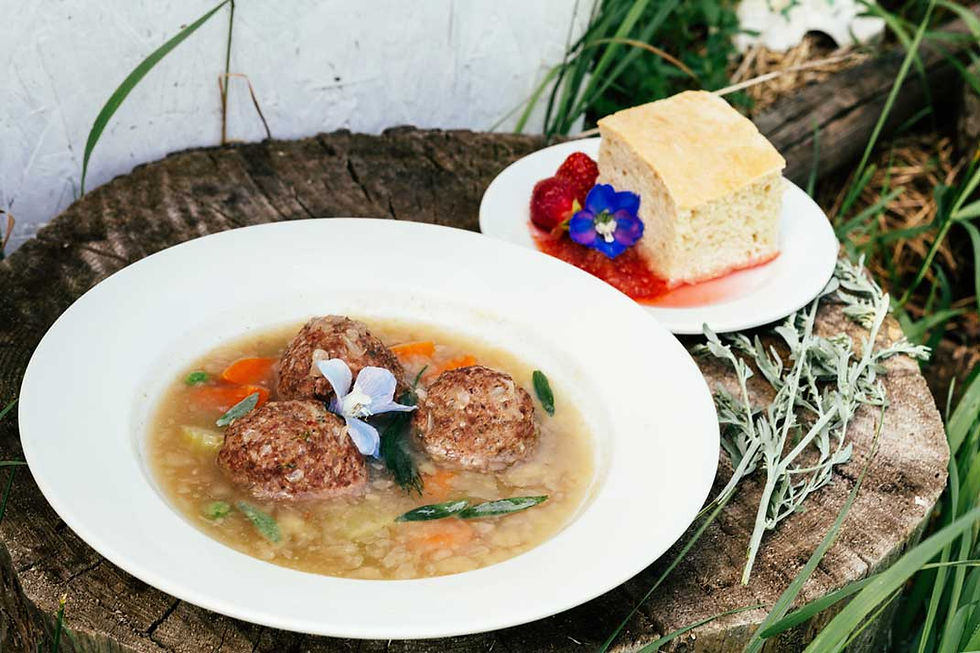Chef’s Tips: Local, Really Local
- Tom Firth

- Sep 3, 2020
- 4 min read
Our September issue regularly focuses on harvest and seasonal dishes, but as this is a year unlike any other, we reached out to Indigenous or First Nations chefs working around the province for their takes on locally sourced dishes that celebrate the cuisine of the first inhabitants of the land around us.

Brad Lazarenko is a busy man. Not only the founder and chef of the Culina family of restaurants, he’s also the culinary director of Métis Crossing in Smoky Lake County, Alberta.
“Like the Métis,” Lazarenko tells us, “our favourite dishes come from a fusion of past and present, of European and First Nations, and local and international influences… our philosophy has been to bring in Indigenous chefs to create dishes that guests will travel miles to enjoy.”
Little known, but according to Lazarenko: “The origin of bannock is often confused as Indigenous cuisine. It is very Métis and was introduced by the Scottish people”. As for suggestions or tips for cooking at home, chef advises to, “shop seasonally and trust your local farmer. Locally produced food (organic or not) will always be more expensive, but the quality is always better - plus your money stays in the local economy.”
For something a little different, try Chef Lazarenko’s Métis Boulettes

Chef Billy Alexander is a man in transition. He’s been a consulting chef for Westjet, and the Executive Chef for Little Chief and the Grey Eagle Resort and Casino, but headed to the Caldwell First Nation in Southern Ontario at the end of the summer to start a new restaurant, “3 FIRES” - an indigenous culinary experience planned to be both interactive and informative about the history and culture of the Caldwell people through food and drink.
Chef would like to clarify the thought that indigenous people only ate meat and relied on the hunt. “Yes, it is true that we were reliant on the hunt for our meat, but we were largely reliant on our ability to live off the land. Our ability to forage, gather, and garden is what really gave us the day to day nourishment.”
Chef Alexander is also quick to correct that indigenous cuisine is a new type or food or even a fad. “Indigenous cuisine has been around for as long as indigenous people have been here, and that dates back over 14 thousand years. I like to tell people it’s the longest running fad in the history of these great lands.”
For tips on selecting ingredients, Chef Alexander shares, “I am a believer in eating seasonally and sourcing ingredients seasonally. It is simple, it promotes local, and it is always fresh.” He adds, “If you are looking for game meats, my preference is always wild if possible. If that isn’t an option, go to a local butcher where you can usually find venison, bison, elk, or boar, to name a few.”
For a complete and delicious meal, try Chef Alexander’s 3 Sisters Salad with Cedar Plank Salmon.

David Landage is the executive chef at the Clarion Hotel and conference center (soon to be Hilton Double Tree) and is passionate about locally sourced ingredients for the Cross Roads Kitchen, but looking to embrace the flavours and culture of Calgary and its environs.
Chef Ladange shares that: “While many people associate venison or deer meat with historical Native American recipes, people from all across the nation also ate rabbit, buffalo, mutton, pork, both saltwater and freshwater fish, and a variety of shellfish.”
But he cautions that aiming for historical accuracy: “Many people believe that you should only use ingredients that were naturally found in North America. This leaves out many delicious ingredients that use wheat flour, mutton, or any other foods that were brought over from the old world of Europe.”
According to Chef Ladange, when sourcing ingredients: “The native people from North America were skilled farmers by the time the European settlers showed up. Even when they gathered natural food during their nomadic migrations, they enjoyed a host of vegetables, wild grains, and herbs to flavour their recipes. Some of these included melons, nuts, mushrooms, cactus, cabbage, onions, sage, mint, and pumpkins. Whenever possible, support local farmers and markets.”
Chef Landage shares his comfort food dish of Bison Short Ribs and Navajo Fry Bread.

Chef Shane Chartrand is the Culinary Ambassador for the River Cree Resorts and Casino, but he’s well known as a contestant and judge for a number of culinary shows such as Iron Chef, Chop Canada and several others. A man in demand for his work with indigenous groups all over the country, and passion for sharing and promoting good food, more recently Chartrand has been earning accolades for his book; tawâw: Progressive Indigenous Cuisine, written with Jennifer Cockrall-King.
Spending a great deal of time on the road most years (this is an unusual year in so many ways), and working with fine dining as well as various indigenous groups, at home Chartrand enjoys “humble” foods like pastas and Bolognese, Mediterranean-style cuisine and the like, though he’s also an avid fisherman and hunter, which ties into his indigenous roots.
“People rarely understand what indigenous cuisine really is,” he says. “It’s terroir – local, really local ingredients prepared in a delicious fashion; eating from the land, but we don’t do it all the time.” Chartrand laments that information about indigenous cuisine is somewhat hard to find: “it’s why we wrote the book,” he says.
As for a tip for those at home, Chartrand takes a different, if practical, approach: “Get a good chopping block. Invest in a good set of knives too. Give yourself space and time so you don’t get frustrated during the process. Clean as you go.”
For an easy and delectable snack or side dish, try Chef Chartrand’s Puffed Fried Rice from his cookbook.











Comments